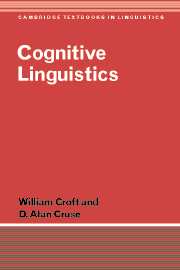Book contents
- Frontmatter
- Contents
- Figures
- Tables
- Preface
- 1 Introduction: what is cognitive linguistics?
- A conceptual approach to linguistic analysis
- Cognitive approaches to lexical semantics
- Cognitive approaches to grammatical form
- 9 From idioms to construction grammar
- 10 An overview of construction grammars
- 11 The usage-based model
- 12 Conclusion: cognitive linguistics and beyond
- References
- Index
- Index
12 - Conclusion: cognitive linguistics and beyond
Published online by Cambridge University Press: 05 June 2012
- Frontmatter
- Contents
- Figures
- Tables
- Preface
- 1 Introduction: what is cognitive linguistics?
- A conceptual approach to linguistic analysis
- Cognitive approaches to lexical semantics
- Cognitive approaches to grammatical form
- 9 From idioms to construction grammar
- 10 An overview of construction grammars
- 11 The usage-based model
- 12 Conclusion: cognitive linguistics and beyond
- References
- Index
- Index
Summary
The contemporary movement of cognitive linguistics began largely as an approach to the analysis of linguistic meaning and grammatical form in response to truth-conditional semantics and generative grammar. In this book, we have focused on the analyses of syntax and semantics in cognitive linguistics, based on the three fundamental hypotheses presented in chapter 1: language is not an autonomous cognitive faculty; grammar is conceptualization; and knowledge of language emerges from language use. However, these basic hypotheses have consequences beyond the narrow confines of linguistics, and also the narrow confines of the mental representation of linguistic knowledge. A number of cognitive linguists have pushed the boundaries of cognitive linguistics; conversely, a number of critics have challenged cognitive linguistics to go beyond its boundaries. We conclude our survey by pointing out some of the ways cognitive linguistics has gone, and should go, beyond its boundaries.
The hypothesis that language is not an autonomous cognitive faculty has implied that conceptual structures and processes proposed for language should be essentially the same as those found in nonlinguistic human cognition. At first, this meant that cognitive linguists drew on the results of cognitive psychology (and, to a lesser extent, philosophy) in developing cognitive linguistic analyses. It also led to the analysis of conceptual structure using linguistic evidence, as described in Part I of this book. More recently, the reverse has taken place: cognitive linguists have applied the conceptual analyses of cognitive linguistics to other cognitive domains.
- Type
- Chapter
- Information
- Cognitive Linguistics , pp. 328 - 329Publisher: Cambridge University PressPrint publication year: 2004



